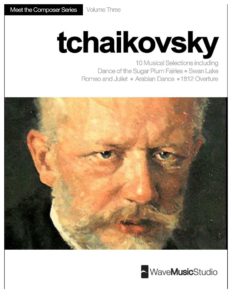P.I. Tchaikovsky – Waltz From The Sleeping Beauty Suite – Rachmaninoff Four Hands piano arrangement, with sheet music.

Rachmaninoff’s arrangement of Tchaikovsky’s Waltz from the Sleeping Beauty, arranged for four hands. Performed by the Aurora Duo.
In 1890, Alexander Siloti was approached to arrange the music for piano duet. He declined, but suggested his then 17-year-old cousin Sergei Rachmaninoff would be more than competent. This offer was accepted, although Siloti supervised the arrangement. Rachmaninoff himself arranged the entire score for piano solo. This is one of those melodies we’ve all heard since we were children, timeless in its beauty. It was famously featured in Disney’s “The Sleeping Beauty”, where Aurora waltzes along with her Prince to the piece. Truly one of my favorites since I was a child. I recently had the chance to perform this with a friend, and it’s an extremely fun piece to play.
It’s not very virtuosic either and falls under the fingers well, so grab a friend and try it!
The Sleeping Beauty (suite)
Instrumentation
Scored for piccolo, 2 flutes, 2 oboes, English horn, 2 clarinets (in A, B-flat), 2 bassoons + 4 horns (in F), 2 cornets (in A, B-flat), 2 trumpets (in A, B-flat), 3 trombones, tuba + 3 timpani, side drum, cymbals, bass drum, tam-tam, glockenspiel + harp, violins I, violins II, violas, cellos, and double basses.
Movements and Duration
There are five numbers, lasting around 20 minutes in performance:
- Introduction [Carabosse’s music from the ballet’s introduction, linked with the appearance of the Lilac Fairy from the end of Act I, No. 9]
- Adagio [Act I, No. 8a]
- Pas de caractère [Act III, No. 24]
- Panorama [Act II, No. 17]
- Waltz [Act I, No. 6]
History
“In view of the fact that you are pleased with all the music for The Sleeping Beauty, what about making either one or even two suites from it?”, Tchaikovsky suggested to Pyotr Jurgenson on 14/26 February 1890, a few weeks after the premiere of the ballet.
“If yes,” he continued, “then I would entrust the selection of numbers to Ziloti. The conductor Engel has for some time expressed a desire to play such a suite in his Aquarium already some time ago long. I conclude from this that there is a demand”. In response to a question from Pyotr Jurgenson, Tchaikovsky developed the idea in his letter of 28 February/12 March: “Apropos of the suite, I referred to Ziloti on the grounds that in my view he is best placed to indicate exactly what should be included in the suite. It is not necessary to change a single note. What goes for a symphony is the same for a ballet! Of course the Waltz will go in, but there are many other numbers suitable for concert performance. And this should be referred to Ziloti.
He is generally sympathetic to my music, and while he is not the author, the latter invariably makes mistakes in the appraisal of his creations. I do think that the second scene of Act II (Sleep) ought to be included, but let Ziloti decide. In any case one suite should be sufficient — not because everything is outstandingly good, but because the whole ballet is of equal merit”.
Without having arrived at a resolution, on 4/16 June Tchaikovsky asked Pyotr Jurgenson to postpone the question of the suite. “Regarding the suite from the ballet, I ask you to wait until July, because then I’ll be in Petersburg and will hear the suite made by Keller.”.
However, even in October the matter of the suite had not yet been decided. “As far as the ballet is concerned, by God, I cannot decide. It is usually difficult for me to determine which are the best of my works. Everything seems equally good or is equally foul to me, depending on whether or not I am satisfied with a piece. In this case I will say only that The Sleeping Beauty pleases me in its entirety from the beginning to he end.
The simplest resolution of the question would be to engrave the complete full score. But I know that this is asking too much. It only remains to print one number at a time, in order to stimulate the public interest. And so, first of all have the Waltz engraved, then the Panorama, and then in this order: from the prologue: 1) March, 2) Dances of the Fairies, 3) Closing scene; from the first act: 1) Pas d’action, 2) Beauty’s variation, etc, etc. In any case I decline to compile a suite from the ballet. That made by Engel is a pot-pourri, which I do not want; I’d rather select 4, 5 either 6 numbers that can stand alone as independent compositions — which is impossible, or at least I cannot do it. If you want to have a suite, then I must again refer you to Ziloti.
In the past year he made lists of numbers for two suites, but I mislaid the paper upon which they were written. I am now firmly against a suite, and in favour of the publication of individual numbers. I do not have the ballet to hand, and I cannot put together a complete list. The fourth scene (probably the best part of the whole score) must be printed in its entirety”.
Publication
During Tchaikovsky’s lifetime the concept of a suite remained unrealised. However, in December 1899 Jurgenson brought out a suite with five numbers for large symphony orchestra (Op. 67-bis), under Aleksandr Ziloti‘s editorship, and also in a two-hand arrangement for piano by Eduard Langer.
Performances
The earliest-known performance of the “Op. 66a” suite seems to have been at the Winter Gardens in Bournemouth (England), on 25 December 1900/7 January 1901, conducted by Dan Godfrey.
Browse in the Library:
Or browse in the categories menus & download the Library Catalog PDF:
